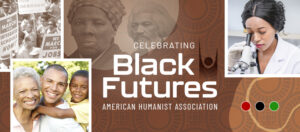Black Futures, Diasporic Solidarity

The communications team at the American Humanist Association has adopted a 2023 strategic content calendar to refresh and invigorate collective conversations on topics not typically seen as “humanist issues.” February’s theme is “Black Futures, and Diasporic Solidarity”. We left the themes intentionally open because we want to invite our legacy and emerging audiences and community members to engage in new and creative ways. The programming for this month includes an interactive webinar with David Dean exploring the 17th-century social construct of race and more specifically “whiteness,” member and chapter-focused programming from the Center for Education, and (of course) building awareness of all that our movement has and will continue to accomplish.
I have not always been Black. Over the course of my life the language I used to locate myself was influenced by many overlapping socio-political, economic, and cultural factors. In early adolescence I was taught that I was half Black and half white or “mixed.” The colorblind politics, influenced by disinformation campaigns to defang Pan-African, Black Power, and Civil Rights movements, influenced my working class mother significantly. She bought into the myth that her whiteness afforded her Black multi-ethnic children a measure of safety. Whether it was an oversimplification in support of my developmental stage or other intentions, being taught that I was “equally as white” because of my mother’s racialization led to confusion and danger. My hair, nose, skin tone, culture, and political positionality embodied African American-ness.
I have been Black my whole life, if Black is fugitivity from anti-Black social constructions and the production of white supremacy on our institutions, bodies, and bonds to one another. If Black is a product of social construction, with real material outcomes of the safety, dignity, and belonging as those racialized as Black; Whiteness too has material conditions fashioned in the same epistemological euro modern imagination. By the time I entered my early twenties I made a political choice to be, what Lewis Gordon calls, capital “B” Black. That is to say, I committed myself fully to the struggle to deconstruct the psycho-social scaffolding embedded in my consciousness that led me to believe that my aesthetic appearance relegated me to perpetual victimhood. I entered into a commitment to the struggle against oppression wherever I found it in myself and the world. In liberating myself from my psychic subjugation, the cracks on the project of racecrafting began to appear.
What can a Black futures mean when Blackness can exist or not exist across overlapping spaces and times? Bayo Akomolafe’s provocation problematizes black lives and black bodies further by revealing how Black Lives Matter is a different side of the same white supremacy coin: “I am writing to say that while Black Lives Matter deploys an identitarian approach to make its demands and claims about Black experience legible to the public, it inadvertently contributes to the ongoing manufacturing of the Black subject.”
As we explore Blackness, Whiteness, and diasporic solidarity during the backdrop of Black History Month, I hope we anchor ourselves deep in our humanist values. I hope we remember that our freedom comes from struggling together into the future, and not fear-based deference. We are incentivized to atomize our identities. I do not believe that human experiences can be so neatly contained, and so February is an invitation to expand and invite nuance and complexity. Unlinking diaspora from aesthetics, what could return look like for the exiled and dispossessed? I have more questions than answers.
May we invite skepticism to broadly accepted versions of Black mattering, victimhood, and trouble the waters of familiarity in order to arrive at that which can never be denied: together, we are all and always will be human.
